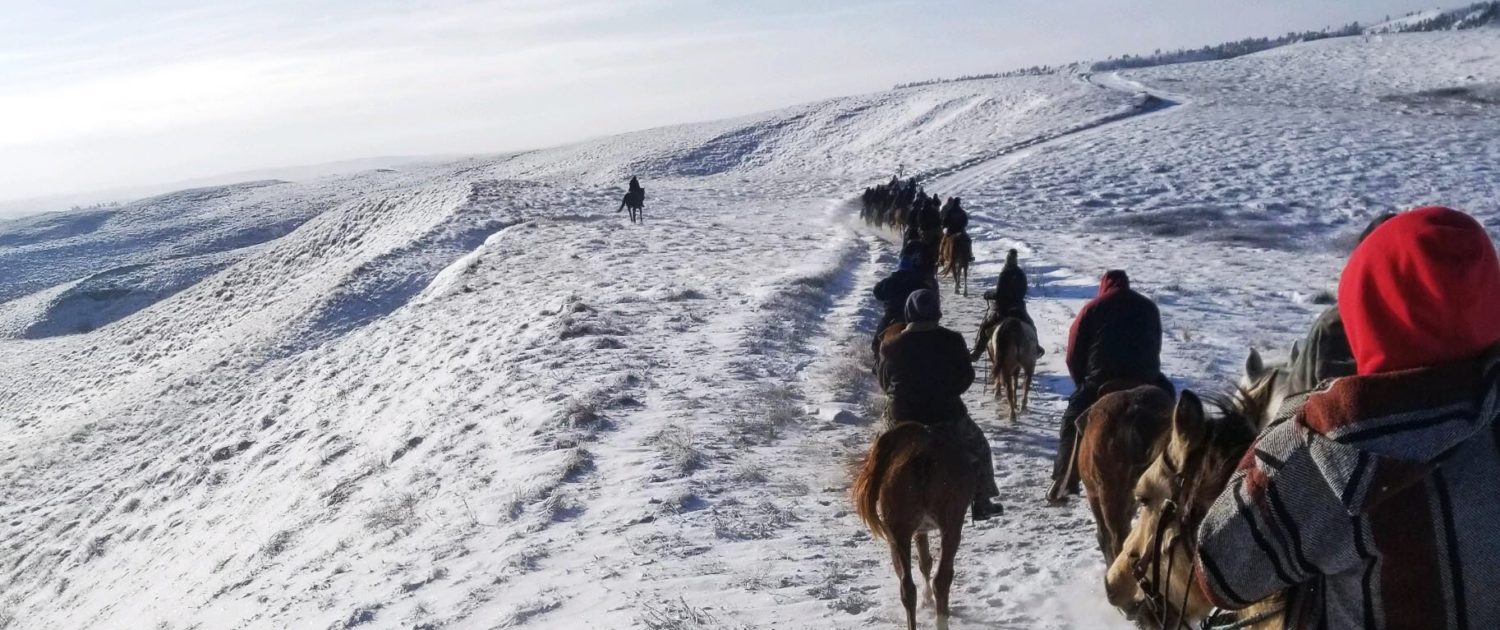Affiliate Spotlight: Horse Spirit Society
“It’s a powerful, powerful time for our people. We go there with the thought of the massacre, we open ourselves up to prayer, and we think about them. It’s a sacred time for our people to come on this ride.”
One of our newest Affiliates, the Horse Spirit Society or in Lakota language, Sung Nagi Okolakiciye, is run by Percy White Plume. The Horse Spirit Society focuses their work on running horse camps for children, which centers on traditional cultural teachings and the role of the horse in Lakota culture. They also offer cultural riding camps for the community, participating in about three to five camps throughout the year. One of their most attended camps is their annual Chief Big Foot Memorial Ride.
Riders on horseback travel on an eight-day journey through the snow-covered plains to remember and honor the ancestors who lost their lives at the Wounded Knee massacre. The ride starts on the 23rd of January and concludes on the 30th.
We had the honor of speaking to Percy, who has been a part of organizing the Ride since 1988. In our conversation with him, he reflected on what it means to him and to others’ who join in on the ride. As well as offered knowledge about the cultural and historical significance of the places they visit along their journey.
Wounded Knee Massacre 1890
On December 29th, 1890, the 7th cavalry came to the Red Could agency were Chief Bigfoot and his people had relocated. The cavalry strategically ordered all weapons that the Lakota people had to be surrendered to the army. They had also instructed all the warriors to go to the center of the encampment, where an argument soon ensued leading to the massacre. Bullets & cannons began to go off in every direction, wiping out the unarmed Lakota, who had no choice but to scatter in all directions.

Image provided by Stormi.
The death toll of this horrific massacre is estimated at 250 Lakota men, women, children, and elders who lost their lives at Wounded Knee. Keeping in mind the uncounted bodies of people who died fleeing in the woods, and the many, many more who succumbed to their injuries.
Percy picked up a Lakota elder who was walking along the road and gave her a ride. In the car she spoke in her language and asked him why the riders don’t come through Pine Ridge. Percy remembered what she said.
“A lot of the wounded they took to Pine Ridge, died in Pine Ridge. And when you don’t ride over there, it’s like you forget about them.”
Many of those that join the ride are descendants of the Lakota that were killed in Wounded Knee. Percy shared that there were five young Lakota men, that survived the massacre, escaping into the hills in what is now Oglala, SD. The Riders have been stopping in Pine Ridge in acknowledgment of the relatives that survived the massacre and their descendants, for the last ten years.
After the massacre, the army hospital refused to treat the wounded Lakota. But a doctor by the name of Doctor Eastman agreed to help treat the wounded Lakota in a Church in Pine Ride. Although not located in the exact spot where it once stood, the original church, St John’s Church, is still on the reservation today. Many of the remaining survivors died there.
“When I walked into that Church, it took me back to a time of… It just looked like a real… In my mind, I could almost see where the people were lying. It looked like a flash to me. So it was really a change for me to go and actually, and we talked about it, go to that church.” said White Plume.
The Horse Spirit Society invites and encourages anyone to join them for the Chief Bigfoot Memorial Ride as long as they do so in a respectful and supportive way. More information can be found on their Facebook page, Horse Spirit Society.
“You get to Wounded Knee, you say a prayer, and you give that to our relatives… All the bad stuff, you know? So, they can take it and, take it wherever it won’t bother anybody. So, when you get to Wounded Knee, afterwards… It’s like a big breath of fresh air. So, it’s a healing ride in a way.”




